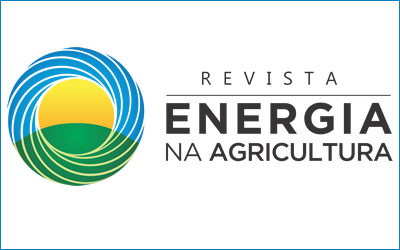PRODUÇÃO DE SOJA NO ESTADO DO MARANHÃO E SUA RELAÇÃO COM O PRODUTO INTERNO BRUTO
DOI:
https://doi.org/10.17224/EnergAgric.2023v38n3p1-11Resumo
SOYBEAN PRODUCTION IN THE STATE OF MARANHÃO AND ITS RELATIONSHIP WITH THE GROSS DOMESTIC PRODUCT
PATRYCIA ELEN COSTA AMORIM1, JÉFFERSON DE OLIVEIRA COSTA2, MATHEUS AUGUSTO SILVA1, HARIELLY TYANNE GABRIEL TARGINO1 AND CARLOS ALBERTO QUILOANGO-CHIMARRO3
1Department of Agronomic and Forestry Sciences, Federal Rural University of the Semi-Arid/UFERSA, Av. Francisco Mota, 572, Costa e Silva, 59625-900, Mossoró, RN, Brazil. e-mail: patrycia_amorim@hotmail.com; matheusdiglay17@gmail.com; hariellytyanne15@gmail.com
2Minas Gerais Agricultural Research Agency/EPAMIG, Experimental Field of Gorutuba, 39525-000, Nova Porteirinha, MG, Brazil. e-mail: costajo@alumni.usp.br
3Biosystems Engineering, University of São Paulo–ESALQ/USP, Av. Pádua Dias, 11, São Dimas, 13418-900, Piracicaba, SP, Brazil, e-mail: caquiloango@usp.br
ABSTRACT: Maranhão (MA) State is among the ten largest soybean producers in Brazil and is the second largest producer in the northeastern region, with an average yield of 2,915 kg ha-1, and the evolution of this production has positively influenced the Municipal Gross Domestic Product (GDP). Thus, this study aimed to characterize soybean production in MA, analyzing data from the main producing municipalities from 2010 to 2019 and relating the value of soybean production to GDP in the period. Municipal Agricultural Production and Municipal GDP data from the Brazilian Institute of Geography and Statistics were used to carry out exploratory and descriptive analyses, simple linear regression, and Pearson's correlation. To characterize the factors that influence crop yield, monthly graphs of temperature and pluviometric index were elaborated for the period of the soybean cycle in MA. The results indicated that the MA planted area evolved significantly and plantations were concentrated in the municipalities of Balsas and Tasso Fragoso, which also had the highest yields in the period, with 619,997 and 616,672 Megagram in 2018, respectively. The highest yield was observed in Buriticupu (3,900 kg ha-1) in 2019. The survey showed a strong and significant relationship between the value of production and GDPs.
Keywords: agribusiness, agricultural cultivation, Glycine max L.
PRODUÇÃO DE SOJA NO ESTADO DO MARANHÃO E SUA RELAÇÃO COM O PRODUTO INTERNO BRUTO
RESUMO: O Estado do Maranhão (MA) está entre os dez maiores produtores de soja do Brasil e é o segundo maior produtor da região nordeste, com um rendimento médio de 2.915 kg ha-1, sendo que a evolução dessa produção tem influenciado positivamente no Produto Interno Bruto (PIB) Municipal. Assim, o trabalho teve como objetivo caracterizar a produção de soja no MA, analisando dados dos principais municípios produtores no período de 2010 a 2019 e relacionando o valor da produção da soja com o PIB deste período. Foram utilizados dados de Produção Agrícola Municipal e PIB Municipal do Instituto Brasileiro de Geografia e Estatística para realização das análises exploratórias, descritivas, regressão linear simples e correlação de Pearson. Para caracterizar fatores que influenciam no rendimento da cultura, elaborou-se gráficos mensais de temperatura e índice pluviométrico no período do ciclo da soja no MA. Os resultados indicaram que a área plantada do MA evoluiu de forma significativa e os plantios concentraram-se nos municípios de Balsas e Tasso Fragoso, que também apresentaram as maiores produções no período, com 619.997 e 616.672 toneladas em 2018, respectivamente. O maior rendimento foi em Buriticupu (3.900 kg ha-1) em 2019. A pesquisa evidenciou a relação forte e significativa entre o valor da produção e os PIBs.
Palavras-chave: agronegócio, cultivo agrícola, Glycine max L.
Downloads
Publicado
Como Citar
Edição
Seção
Licença
Copyright (c) 2024 ENERGIA NA AGRICULTURA

Este trabalho está licenciado sob uma licença Creative Commons Attribution-NonCommercial-NoDerivatives 4.0 International License.
Esta revista proporciona acesso publico a todo seu conteúdo, seguindo o princípio que tornar gratuito o acesso a pesquisas gera um maior intercâmbio global de conhecimento. Tal acesso está associado a um crescimento da leitura e citação do trabalho de um autor. Para maiores informações sobre esta abordagem, visite Public Knowledge Project, projeto que desenvolveu este sistema para melhorar a qualidade acadêmica e pública da pesquisa, distribuindo o OJS assim como outros software de apoio ao sistema de publicação de acesso público a fontes acadêmicas.





